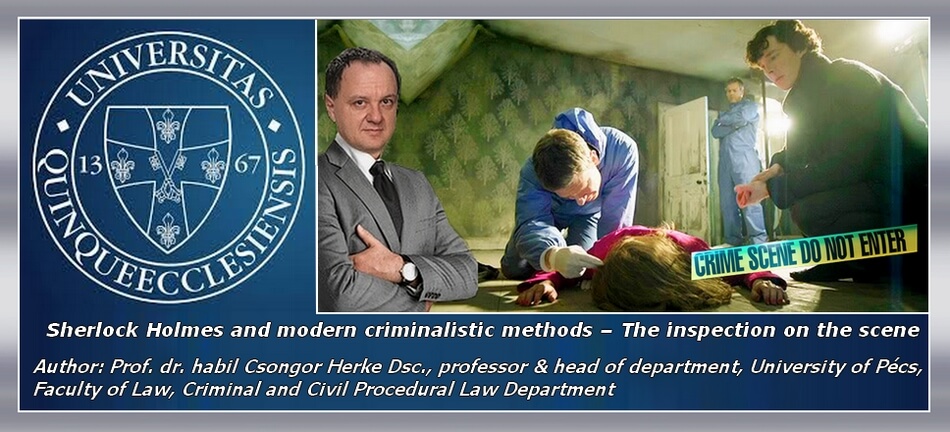Sherlock Holmes and modern criminalistic methods – The inspection on the scene

Author: Prof. dr. habil Csongor Herke Dsc., professor and head of department, University of Pécs, Faculty of Law,
Criminal and Civil Procedural Law Department

Sherlock Holmes and modern criminalistic methods – The inspection on the scene
I. Introduction
Forensic science is traditionally divided into three parts: criminal science, criminal tactics and criminal methodics.
Criminal science serves for practical and professional use of scientific and technical tools and methods in crime detection. These tools and methods may either
be the results of other branches of science and specialties without any modification that criminal science is able to use effectively (for example physical or
chemical equipments, measuring methods, optical or computer devices, etc.). Or, they can be improved by criminal tactics to be utilizable during the
investigation (for example crime scene photography, sound analysis, serologic tests etc.). And finally, there are significant disciplines that are mainly and
specifically created, developed and established by criminal science itself (for example trace analysis (trasology), recording of fingerprints and identificating
them (dactyloscopy, forensic graphology, ballistics etc.).
Criminal tactics does not focus on material sources of information, it rather deals with the main features and connections of individual-based evidence gaining
phases (accused people, victims, witnesses and participating experts). The main subjects of criminal tactics are crime scene investigation, attempt of proving,
exhibition for identification, interrogation, confrontation, the tactics of compulsive measures.
The third part of criminalistics is criminal methodics. It does not deal with the efficient investigation in general, it focuses directly and specifically on detecting
and proving certain crime categories (like murder or burglary). It combines and adapts all the basic knowledge of criminal tactics and criminal technics the best
possible way.
Criminalistics or scientific criminology is a very young branch of science, the first written works on it appeared at the end of the nineteenth century. Many
consider Hans Gross as its founding father, whose two-volume book entitled Criminal Invstigations, a Practical Textbook (original title: Handbuch für
Untersuchungsrichter als System der Kriminalistik) was published in 1893. In fact, he created criminalistics as a separate branch of science.(1)
Edgar Allan Poe was the first author to write about the different methods of criminal technics and tactics. But the debut of criminalistics can be undoubtedly
connected to Sherlock Holmes, the creature of Sir Arthur Conan Doyle. The detective can be seen as the literary father of scientific criminology, because he
used its multiple methods – he investigated traces and samples, examined and explored crime scenes.
Some say that the activities of Sherlock Holmes are closer to natural sciences. His aim in almost every case is to precisely record and analyze traces. At the
same time we can state that we can use the methods of criminal tactics the most from the adventures. Namely criminal technics developed so rapidly in the last
century that the methods applied by Holmes cannot be considered really modern. For example, in A Study in Scarlet Holmes says: ”I have found a re-agent
which is precipitated by haemoglobin, and by nothing else.” At that time it truly was an amazing discovery, but in the age of DNA identification science
transcended the mere showing that a contamination what is suspected to be blood is really that.
For that very reason we focus our attention to the methods of criminal tactics. Firstly, to inspection on the scene.
2. Inspection on the scene
Inspection on the scene is a necessarily complicated and generally urgent investigative act and means of evidence during which the condition and the
circumstances of the crime scene are detected and documented according to the rules of procedure and investigators search for traces, changes in the crime
scene and the connections between them.(2)
The inspection on the scene has a double aim.
On the one hand, to give directly usable data and points of reference to the further investigation, specifically to set up general and partial versions of the possible
events.
On the other hand, both the inspection on the scene in itself and its results prove facts during the judicial process that are relevant in criminal law – in the long
run, to serve as evidence, and to help inspect further evidence related to the specific case.
The crime scene is the place where the suspected crime is committed, or where other parts of action, events and so on that belong to or are related to the crime
happened. The preparation and the conduction of the inspection on the scene greatly depends on the type of the scene. According to this a crime scene can be
- real
- fictional (set)
- changed
- multiple (proportioned)
- moving
- „living”.
Real crime scene shows the place where a real crime had been committed, while the fictional is one that is pre-set. A changed scene is one that is partially set,
where the perpetrator deliberately makes changes and leaves fake traces to mislead the invetigation. These fake traces refer to other motifs and perpetrators, or
rather he/she wants to cover up his/her own traces, or these are simply unnecessary additional actions. When there is a reasonable suspicion of a series of
crimes, it is a multiple crime scene. Beyond that, it is often happens that there are additional scenes that are important (for example, whre the victim was killed,
dismembered, where the loot was hidden, where the perpetrator was waiting for the opportunity, from where he/she fired the gun etc.). Often there are so-called
negative circumstances that also refer to a multiple crime scene – the lack of traces and changes that are expected or likely to be there, based on the condition. Moving scenes, which are means of transport, cause several problems (there are relatively few traces, many other persons cause changes, the withdrawal from
traffic is complicated), but, at the same time these are a quite good point of reference regarding the time and the duration of the crime. A living scene causes the
most problems (for example a crime committed in a functioning hospital or hotel; arson or detonating in a working factory; or when the vehicle itself is
seriously damaged in a crash). In such cases the saving of lives and properties, the public interest (the continuation of the traffic), and damage control in general
modifies the crime scene greatly.
Primarily we have to distinguish inspection on the scene according to the dangers the delay holds to the crime scene. With respect to this point of view there are
a) inspections on the scene that are cannot be postponed,
b) inspections on the scene that are carried into effect after the investigation was issued (these can be postponed).
Further categorization can be based upon regarding the fact that were there any denunciations made or not, either at the start of the inspection on the scene or
after it. It would also be useful to note whether concerned parties took part in it or not. Additional question is that an inspection on the scene often ends with
confiscating clues (corpus delicti) when it was successful. The results of the inspection on the scene may direct other denunciations. Finally, it is justifiable to
make a difference regarding whether the inspection on the scene is replaceable or not – based on this there is one-time conduct and repeated carrying out, and
we also distinguish inspection on the scene and orientation at the crime scene.
Fast and effective conduct of the inspection on the scene substantively depends upon the level and accuracy of preparation. Notably
- what forces are necessary and possible to involve,
- what combination of groups should do the substantive work (inspection board, group of investigators),
- is it possible to ensure the tangible requirements of the inspection on the scene, ranging from technical terms (trace tracking devices, recording equipments,
etc.) to lightning, communication and traffic.
Securing the scene is a very important part of preparation, because it can ensure that the crime scene remains free from changes and modifications. Securing an
open space requires significantly more efforts (for example, closing the area, making a hurdle, diverting traffic etc.). When the crime happened at an inside
place, temporarily it is enough to ask the witness who detected the crime to save the scene from any outer impacts.
On one hand, we have to make urgent actions
- to avert dangers threatening the life, health and property of civilians,
- to follow the clues,
- to follow a hot trail (in case of special crimes).
On the other hand, we have to orient at the crime scene. Primarily, the leader of the board
- listens to the report of the person who secured the scene,
- interrogates the victim and the witness who detected the crime,
- estimates the needed actions and whether the personal and material requirements are provided.
The tactical requirements of the inspection on the scene differ largely during its two main phases. During the first (static) phase the main requirement is to
observe and record every phenomena and circumstance of the scene. During the second phase the scene is no longer in a rest, a searching is done what covers all
details, and the objects, equipments, furnitures and other things need to be moved from their original place – that’s why it is aptly called the dinamic phase.
The most important means to record the inspection on the scene is the crime scene report, which is formal and practically indispensable. As a general
requirement we stress that it may contain the description of the objective condition of the scene – the traces, material changes, mineral remains. It cannot
contain subjective statements of the investigating board or the investigator (opinions, deductions, assumptions or versions). The report consists of three parts:
introduction, description and clause. Additionally, the report may have further annexes (plot, photographs, video footage, the dog handler’s report, the report of
the leading detective).(3)
3. The inspection on the scene in the Sherlock Holmes stories
First of all, we have to stress that according to the rules above Sherlock Holmes emphasizes the static phase of the inspection on the scene in most of the
adventures. In almost every case when he investigates the crime scene, he collects traces, his first action is to make a general ground-scouting and to record his
observations. We can notice this in The Red-Headed League. Here the ground-scouting is basically the static phase of the inspection on the scene:
„We travelled by the Underground as far as Aldersgate; and a short walk took us to Saxe-Coburg Square, the scene of the singular story which we had listened
to in the morning. It was a pokey, little, shabby-genteel place, where four lines of dingy two-storied brick houses looked out into a small railed-in enclosure,
where a lawn of weedy grass and a few clumps of faded laurel bushes made a hard fight against a smoke-laden and uncongenial atmosphere. Three gilt balls and
a brown board with »JABEZ WILSON« in white letters, upon a corner house, announced the place where our red-headed client carried on his business.
Sherlock Holmes stopped in front of it with his head on one side and looked it all over, with his eyes shining brightly between puckered lids. Then he walked
slowly up the street and then down again to the corner, still looking keenly at the houses. Finally he returned to the pawnbroker’s, and, having thumped
vigorously upon the pavement with his stick two or three times, he went up to the door and knocked. It was instantly opened by a bright-looking, clean-shaven
young fellow, who asked him to step in.”
During the described actions Sherlock Holmes investigates the area, and later he makes important deductions based upon his observations. The text follows:
„We know something of Saxe-Coburg Square. Let us now explore the paths which lie behind it.
The road in which we found ourselves as we turned round the corner from the retired Saxe-Coburg Square presented as great a contrast to it as the front of a
picture does to the back. It was one of the main arteries which convey the traffic of the City to the north and west. The roadway was blocked with the immense
stream of commerce flowing in a double tide inwards and outwards, while the footpaths were black with the hurrying swarm of pedestrians. It was difficult to
realize as we looked at the line of fine shops and stately business premises that they really abutted on the other side upon the faded and stagnant square which
we had just quitted.
’Let me see,’ said Holmes, standing at the corner, and glancing along the line, ’I should like just to remember the order of the houses here. It is a hobby of mine
to have an exact knowledge of London. There is Mortimer’s, the tobacconist, the little newspaper shop, the coburg branch of the City and Suburban Bank, the
Vegetarian Restaurant, and McFarlane’s carriage-building depot.’”
Scene descriptions like that usually have a pivotal importance in proving of the actual case. In order to use the recorded traces and the material (tangible??)
assets seized during the inspection on the scene as evidence, regulations must be complied during evidence collecting. Yet the legitimacy of the source of
evidence can only be proved when the circumstances of obtaining them are thoroughly recorded in an inventory log.
After the static phase comes the dinamic phase of the inspection on the scene, when the traces and evidence are collected. During that the circumstances of
obtaining the found evidence must be recorded as well. A great example for that is in The Dancing Men:
„’I commend that fact very carefully to your attention,’ said Holmes to his professional colleague. ’And now I think that we are in a position to undertake a
thorough examination of the room.’
The study proved to be a small chamber, lined on three sides with books, and with a writing-table facing an ordinary window, which looked out upon the
garden. Our first attention was given to the body of the unfortunate squire, whose huge frame lay stretched across the room. His disordered dress showed that he
had been hastily aroused from sleep. The bullet had been fired at him from the front, and had remained in his body after penetrating the heart. His death had
certainly been instantaneous and painless. There was no powder-marking either upon his dressing-gown or on his hands. According to the country surgeon, the
lady had stains upon her face, but none upon her hand.”
This description is partly an inspection on the scene, but it also contains deductions which belong to the competence of an expert. A crime scene report could
not contain statements like „The bullet had been fired at him from the front, and had remained in his body after penetrating the heart.” Because it is not the task
of the inspection board to decide what have had happened, especially not to make deductions from the data available at the crime scene.
As I mentioned before, the aim of the inspection on the scene is to explore traces and to search for evidence. The report has to contain if based upon the data it is
reasonable to survey further scenes. This other scene may connect to the previous one, but it also may be completely new (for example, there was a bill in the
victim’s pocket that tells that he/she spent the previous night in a hotel). In The Dancing Men there is an example for a further scene:
„’I rather think, Inspector Martin, that we have now exhausted all that this room can teach us. If you will kindly step round with me we shall see what fresh
evidence the garden has to offer.’
A flower-bed extended up to the study window, and we all broke into an exclamation as we approached it. The flowers were trampled down, and the soft soil
was imprinted all over with footmarks. Large, masculine feet they were, with peculiarly long, sharp toes. Holmes hunted about among the grass and leaves like
a retriever after a wounded bird. Then, with a cry of satisfaction, bent forward and picked up a little brazen cylinder.
’I thought so,’ said he; ’the revolver had an ejector, and there is the third cartridge. I really think, Inspector Martin, that our case is almost complete.’”
You can see that during the inspection on the scene many traces can be recorded (in this case they found footprints, that can be useful in identification). On the
other hand, assets for evidence can be seized as well (like the cylinder), from which further evidence may originate (from the cylinder the opinion of the ballistic
expert).
Lastly, we have to mention that several times inspection on the scene serves to secure the scene and to prevent modifying it before recording traces and
evidence. In The Resident Patient the case seems to be a suicide at first glance. Holmes conducts the inspection on the scene as follows:
„He went over to the door, and turning the lock he examined it in his methodical fashion. Then he took out the key, which was on the inside, and inspected that
also. The bed, the carpet, the chaurs, the mantelpiece, the dead body, and the rope were each in turn examined, until at last he professed himself satisfied, and
with my aid and that of the Inspector cut down the wretched object, and laid it reverently under a sheet.”
4. Final thoughts
Conducting an inspection on the scene usually provides valuable data and points of reference to detect crimes. Especially to
- make general and detail versions,
- determine details and peculiarities of the crime (place, time, method, the local and technical knowledge of the perpetrator etc.). These may be important later,
while organizing evidence test and showing for recognition,
- we can get important personality traits and physical characteristics based on the results of the static and the dinamic phase (the number of perpetrators, their
tasks, aims and motifs, habits, methods, practical or unnecessary additional activities etc.),
- almost all data of the inspection on the scene are useful to check different versions and later obtained evidence,
- data and results of the inspection on the scene can help identify a fictional or set crime scene. In both cases evaluation of „negative circumstances” (no traces
or changes, though there should have been some) may be crucial,
- based on the results of the inspection on the scene an ongoing case can be associated with other ongoing or closed cases, for example their modus operandi is
the same or very similar. This way the data may be completed with very important partial results of other cases,
- finally, it is of great importance in itself that based on the evaluation of the inspection on the scene’s results the identification of the scene can be done to our
satisfaction, in other words, we can clarify the condition of the crime scene before and right after the crime (at least how it looked like at the beginning of the
inspection on the scene).
Some of these results are present in almost every Sherlock Holmes story. The detective makes his hypothesis after doing his own inspections on the scene, and
deduces the personality traits and habits of the suspected perpetrator. It is also very common that he makes deductions based upon „negative circumstances”. So
we can say that inspection on the scene is Sherlock’s essential activity of criminal tactics.

Soucers:
(1) Tibor Ibolya: The first Hungarian criminalistics textbook and its author. - ibolyatibor.atw.hu/Sajat/25.pdf
(2) In common language inspection on the scene is called crime scene investigation, though the latter is a term specifically used for interrogation conducted at
the crime scene.
(3) Csongor Herke (ed.): Basics for criminalistic, forensic, psychiatric, auditorial and technical experts, Pécs, 2014.
The source of the excerpts from the Holmes stories: The Complete Illustrated Short Stories by Sir Arthur Conan Doyle, Chancellor Press, 1985.
Translator: Revati
Translator’s note: the author of the article kindly checked and corrected my translation. My sincere thanks for his generous help.
Date: 15/10/2022
© All Rights Reserved.

We are very grateful because Professor Csongor Herke is a VIP member of the The Hungarian Sherlock Holmes Club.
The header shows a crime scene from the BBC Sherlock series.

Keywords: The inspection on the scene, criminology, Sherlock Holmes, crime, forensic science, clues, criminalistic
GO BACK:
Main page
Sherlock Holmes and Edmond Locard

|










